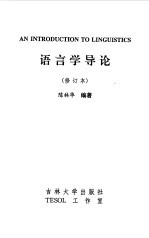

语言学导论PDF电子书下载
- 电子书积分:13 积分如何计算积分?
- 作 者:陈林华编著;TESOL工作室编
- 出 版 社:长春:吉林大学出版社
- 出版年份:1999
- ISBN:7560122337
- 页数:399 页
1.Linguistics:Science of Language 1
Chapter One Linguistics 1
2.Scope of Linguistics 2
3.Approaches to Language 3
4.Grammar 4
5.Schools of Linguistics 5
Exercise 1 8
Chapter Two Language 10
1.Understanding of Language 10
2.Defining Features of Language 11
2.1.Well-organized system of linguistic symbols 11
2.2.Duality of structure 12
2.4.Productivity 13
2.3.Arbitrariness 13
2.5.Displacement 14
2.6.Transferability 14
2.7.Cultural transmission 14
2.8.Linearity 14
3.Language,Unique to Human Beings 15
4.Linguistic Competence and Linguistic Performance 16
5.Social Functions of Language 17
5.1.Language,a communicative means 17
5.2.Language,the means for conceptual thinking and recognition of the world 18
5.3.Langnage,the vehicle and transmitter of culture 20
6.Language and the Human Brain 20
6.2.Functions of the brain 21
6.1.Structure of the human brain 21
7.Conceptual Thinking of the Deaf-mute 23
8.Origin of Language 24
9.Animal Communication Systems 25
Exercise 2 29
Chapter Three Phonetics:Sounds of Language 30
1.Phonetic Alphabet 31
2.English Consonants and Vowels 34
3.Study of Phonetics 39
4.Articulatory Phonetics 40
4.1.Articulatory organs 40
4.2.Discription of English consonants 42
(1)Place of articulation 44
(2)Manner of articulation 46
4.3.Description of English vowels 55
5.Natural Classes of Speech Sounds 59
Exercise 3 60
Chapter Four Phonology:Sound Patterns of Language 63
1.Phonemes:Phonological Units of Language 64
1.1.Distinctive features 65
1.2.Contrast in form and meaning 67
1.3.Nondistinctive features 69
1.4.Phones and allophones 70
1.5.Complementary distribution 71
1.6.Phonetic representation and phonemic representation 72
2.Suprasegmental Features 73
3.Sequences of Phonemes 78
3.1.Constraints on sequences of phonemes 79
3.2.Syllables 80
4.Phonological Rules 82
5.Formalization of Phonological Rules 90
Exercise 4 94
Chapter Five Morphology:Structure of Words 99
1.Morphemes:Smallest Meaningful Units of Language 100
1.1.Morpheme 101
1.2.Morph and allomorph 102
1.3.Analysis of morphemes 103
1.4.Derivational and inflectional morphemes 105
2.Morphological Rules of Word Formation 107
3.Other Ways to Form Words 110
3.1.Conversion 110
3.2.Abbreviation 111
3.3.Back-formation 111
3.4.Blending 112
3.5.Onomatopoeia 112
3.6.Reduplication 112
3.7.Sentence-condensation 113
3.8.Acronymization 113
(1)Alphabetisms 113
(2)Words pronounced as common words 114
4.Phonetic Representation of Morphemes 114
Exercise 5 117
1.Grammatical Rules 120
Chapter Six Syntax:Structure of Sentences 120
1.1.Paradigmatic rules 121
(1)Parts of speech and form classes 121
(2)Inflection 124
(3)Grammatical categories 125
1.2.Syntagmatic rules 133
(1)Combination of morphemes into words 133
(2)Basic patterns of combination of words 134
(3)Constituent structure 136
1.3.Concord and government 141
2.Grammatical Units 142
3.1.Syntactic rules 145
3.Sentence Patterns of Language 145
3.2.Phrase-structure rules 151
3.3.Fitting in morphemes and words 156
3.4.Recursive rules 158
3.5.Surface structure and deep structure 161
3.6.Transformational rules 162
3.7.Phonological and semantic components 171
3.8.Ambiguity in surface structure and grammatical relationships revealed in deep structure 172
Exercise 6 178
Chapter Seven Semantics:Meaning of Language 180
1.Meaning,Concept,Referent 180
2.Sense and Reference 181
3.Meaning of Morphemes and Words 182
4.Semantic Features and Componential Analysis 186
5.Monosemy and Polysemy 187
6.Homonymy 188
7.Sense Relations Between Words 190
7.1.Synonymy 190
7.2.Antonymy 193
7.3.Hyponymy 197
8.Idioms 198
9.Combination of Meanings of Words 201
10.Meaning of Sentences 201
Excercise 7 205
Chapter Eight Pragmatics:Actual Use of Language in Context 208
1.Study of Pragmatics 209
2.Context 212
3.Speech Act Theory 216
3.1.Speech acts 216
3.2.Classification of performatives 219
3.3.Indirect speech acts 221
4.Conversational Implicature 225
4.1.Basic notion of conversational implicature 225
4.2.Cooperative Principle(CP) 227
4.3.Politeness Principles(PP) 228
5.Convensation Analysis 231
5.1.Analysis of the structure of a whole conversation 232
5.2.Analysis of the local structure of a conversation 233
Excercise 8 238
Chapter Nine Language Acquisition 240
1.Stages of Child Language Acquisition 241
1.1.Babbling stage 241
1.2.Holophrastic stage 242
1.3.Two-word stage 243
1.4.Telegraphic stage 244
1.5.Full language-acquistion stage 245
2.Different Views on Child Language Acquistion 246
2.1.Postnatal learning theory 246
2.1.Innate linguistic competence theory 249
Exercise 9 251
Chapter Ten Language and Society 252
1.Relation between Language and Society 252
2.Sociolinguistics 253
3.Dialects 255
3.1.Geographical dialects 256
3.2.Social dialects 257
3.3.Styles 259
3.4.Slang,jargon and taboo 260
3.5.Standard and non-standard dialects 263
4.Lingua Francas 265
5.Pidgin and Creole Languages 266
6.Esperanto:An Artificial Language 273
Exercise 10 275
Chapter Eleven Language,Thought and Culture 276
1.Understanding of Culture 276
2.2.Sapir-Whorf Hypothesis 279
2.1.Relation between language and thought 279
2.Language and Thought 279
3.Language and Culture 284
4.Cultural Overlap,Cultural Diffusion and Translatability 287
5.Culture and Foreign Language Teaching and Learning 290
Excercise 11 296
Chapter Twelve Historical-Comparative Linguistics 297
1.Grimm's Law and Verner's Law:Sound Correspondence 298
2.Languages of the World 300
3.Genetic Classification of Languages 302
4.Language Families 306
4.1.Indo-European Language Family 307
4.2.Sino-Tibetan Language Family 308
4.4.Caucasian Language Family 309
4.3.Afro-Asiatic Language Family 309
4.5.Uralic Language Family 310
4.6.Altaic Language Family 310
4.7.Dravidian Language Family 310
4.8.Malayo-Polynesian Language Family 311
4.9.Niger-Kordofanian Language Family 311
5.Typological Classification of Languages 312
5.1.Isolating languages 313
5.2.Agglutinating languages 314
5.3.Inflectional languages 315
5.4.Polysynthetic languages 318
6.Structural Classification of Languages 318
Exercise 12 321
Chapter Thirteen Language Change 324
1.A Brief History of English 324
2.Phonetic Changes 326
3.Phonological Changes 328
3.1.Changes in phonemes and phonological rules 328
3.2.Great Vowel Shift 331
4.Morphological Changes 333
5.Syntactic Changes 335
6.Lexical Changes 338
6.1.Word coinage 338
6.2.Borrowing 338
7.Semantic Changes 343
7.1.Broadening and narrowing 344
7.2.Elevation and degradation 345
8.Causes of Language Change 346
Exercise 13 349
Chapter Fourteen Writing System 351
1.Origin and Development of Writing 352
1.1.Origin of writing 353
1.2.Development of writing 354
2.Modern Types of Writing Systems 357
3.Reformation of Writing Systems 359
4.Witing and Speech 362
Exercise 14 368
Reference Books 370
Glossory 372
- 《BBC人体如何工作》(英)爱丽丝.罗伯茨 2019
- 《物联网导论》张翼英主编 2020
- 《程序逻辑及C语言编程》卢卫中,杨丽芳主编 2019
- 《材料导论》张会主编 2019
- 《化工传递过程导论 第2版》阎建民,刘辉 2020
- 《慢性呼吸系统疾病物理治疗工作手册》(荷)瑞克·考斯林克(RikGosselink) 2020
- 《幼儿园课程资源丛书 幼儿园语言教育资源》周兢编 2015
- 《掌控工作》邵文瀚著 2020
- 《妈妈365天英语》(韩)申艺莉著 2014
- 《社会工作专业英语》俞炎燊 2019
